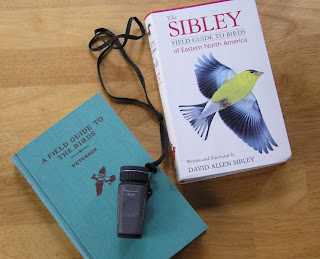A sad commentary on progress and an abandoned rookery

In western Racine County, just outside the Village of Rochester lies the intersection of Nesting Way and Blue Crane Ct. There are no homes on this corner in "Rookery Landing Estates" and only two
"McMansions" in the entire development. You certainly don't have to drive very far to see upscale developments that have become victims of the economy. In fact, you can find them in almost every rural community across the country. What makes this story heartbreaking, is the ultimate departure of the
Great Blue Herons, for which the development was named.
I had heard about the
"rookery" just outside of town from a friend several years ago. Until the farmland was sold for development, the rookery was a well-kept secret and difficult to access. It wasn't until the Spring of 2010 that my husband and I took a drive and wandered down the marked and paved streets of Rookery Landing Estates. We were able to get a magnificent view of upwards of a dozen herons in and around the rookery. Straight out of a scene from Jurassic Park, the site of this community of huge birds perched in their large nests among the treetops was awe inspiring. I imagined the scene resembled what a
pterodactyl colony would have looked like in prehistoric times.
I was, however, deeply troubled by the fact that the first home/mansion built in the development was located right smack dab in front of the rookery. I told myself at the time that whoever had purchased that particular lot must certainly be a bird/nature enthusiast, who would do everything in their power to both preserve and treasure the magnificent display that was "literally" in their backyard. Little did I know at the time, we had witnessed the rookery's last season.
Fast forward to yesterday...I was heading out to do a landscape consultation at a home adjacent to the development. I always bring my camera with me, so when I located the driveway marker, I was delighted that I would be gaining access to the property directly behind the rookery. As I traveled down the dirt drive, I scanned the treeline for a glimpse of the huge twig nests in the trees. To my surprise, there was no trace whatsoever of the rookery that had been there just two short years ago. When I pulled up to the house, the first thing I asked the homeowner was, "where are the herons?" She replied sadly, "they're gone". They had apparently left following the construction of the second home. My heart sank. She indicated that her subsequent inquiries to the Department of Natural Resources as to their whereabouts had gone unanswered.
She proceeded to tell me that the herons had been there since before she and her husband had built their modest colonial back in the sixties. They had managed to co-exist with the herons and always remained cautious around them. They made sure never to walk under the trees, as the birds would become agitated. Being a bird enthusiast like myself, I couldn't imagine her loss after all those seasons of enjoyment. While I was still overcome by a mix of sadness and anger, she told me me that the owner of the home closest to the rookery had lost it in foreclosure...
something about a gambling addiction. I was stunned and managed to inquire, "please tell me that he at least appreciated the herons". She slowly shook her head "no". As if that weren't enough, she indicated that the developer had since abandoned the project. While I realize I am stating information I received second hand, the sad fact remains that after countless decades...the herons are gone.

I have pondered this scenario for over a day now, and I am still perplexed by the total disconnect with nature. Who in the world purchases a lot in the middle of nowhere without having some appreciation of the areas original inhabitants? For years, I have ranted to anyone who will listen about the irony of developers purchasing land and giving their new developments audacious names like Coyote Crossing or Deer Trail Estates, etc. Just the simple act of clearing the land for streets pretty much guarantees the elimination of much of the existing wildlife.
I view the empty streets of Rookery Landing as a scar on the landscape and a sad commentary on "unchecked" progress in the name of personal profit. I hope the herons have found a new, more suitable location for their nursery, and that the DNR remains "mum" on its location. I also hope that the local real estate office that is currently selling the lots is successful, so that a neighborhood may grow out of this once "rich" farm land. Where once young herons fledged from their nests, my wish would be to see homes of a more "modest" size, and yards filled with children playing. And if a few of the resident creatures return to nibble on your prized hostas...SO BE IT!
Note: The Blue Crane, as noted on the street sign at top, is an endangered crane (not heron) native to the southern regions of Africa...not North America.
Belinda's Website







.JPG)












.JPG)






